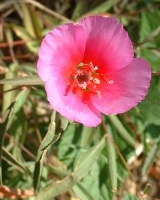
Clarkia amoena
Encyclopedia
Clarkia amoena is a flowering plant
native to western North America
, found in coastal hills and mountains from British Columbia
south to the San Francisco Bay Area
.
It is an annual plant
growing to 1 m tall, with slender, linear leaves
2-7 cm long and 2-6 mm broad. The flower
s are pink to pale purple, with four broad petals 1.5-6 cm long. The fruit
is a dry capsule
, which splits open when mature to release the numerous seed
s.
Three subspecies are currently recognised, though intermediate forms are commonly found:
Farewell to Spring is commonly cultivated as a garden plant, and cultivated varieties are known.
Flowering plant
The flowering plants , also known as Angiospermae or Magnoliophyta, are the most diverse group of land plants. Angiosperms are seed-producing plants like the gymnosperms and can be distinguished from the gymnosperms by a series of synapomorphies...
native to western North America
North America
North America is a continent wholly within the Northern Hemisphere and almost wholly within the Western Hemisphere. It is also considered a northern subcontinent of the Americas...
, found in coastal hills and mountains from British Columbia
British Columbia
British Columbia is the westernmost of Canada's provinces and is known for its natural beauty, as reflected in its Latin motto, Splendor sine occasu . Its name was chosen by Queen Victoria in 1858...
south to the San Francisco Bay Area
San Francisco Bay Area
The San Francisco Bay Area, commonly known as the Bay Area, is a populated region that surrounds the San Francisco and San Pablo estuaries in Northern California. The region encompasses metropolitan areas of San Francisco, Oakland, and San Jose, along with smaller urban and rural areas...
.
It is an annual plant
Annual plant
An annual plant is a plant that usually germinates, flowers, and dies in a year or season. True annuals will only live longer than a year if they are prevented from setting seed...
growing to 1 m tall, with slender, linear leaves
Leaf
A leaf is an organ of a vascular plant, as defined in botanical terms, and in particular in plant morphology. Foliage is a mass noun that refers to leaves as a feature of plants....
2-7 cm long and 2-6 mm broad. The flower
Flower
A flower, sometimes known as a bloom or blossom, is the reproductive structure found in flowering plants . The biological function of a flower is to effect reproduction, usually by providing a mechanism for the union of sperm with eggs...
s are pink to pale purple, with four broad petals 1.5-6 cm long. The fruit
Fruit
In broad terms, a fruit is a structure of a plant that contains its seeds.The term has different meanings dependent on context. In non-technical usage, such as food preparation, fruit normally means the fleshy seed-associated structures of certain plants that are sweet and edible in the raw state,...
is a dry capsule
Capsule (fruit)
In botany a capsule is a type of simple, dry fruit produced by many species of flowering plants. A capsule is a structure composed of two or more carpels that in most cases is dehiscent, i.e. at maturity, it splits apart to release the seeds within. A few capsules are indehiscent, for example...
, which splits open when mature to release the numerous seed
Seed
A seed is a small embryonic plant enclosed in a covering called the seed coat, usually with some stored food. It is the product of the ripened ovule of gymnosperm and angiosperm plants which occurs after fertilization and some growth within the mother plant...
s.
Three subspecies are currently recognised, though intermediate forms are commonly found:
- Clarkia amoena subsp. amoena
- Clarkia amoena subsp. huntiana
- Clarkia amoena subsp. whitneyi (Whitney's Farewell to Spring)
Farewell to Spring is commonly cultivated as a garden plant, and cultivated varieties are known.

